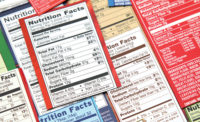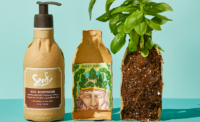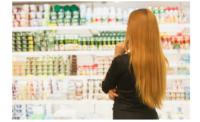Spotlight Feature
What Does Your Labeling Say?
Labels communicate to consumers about your brand — be it a recycling claim, nutrition benefits, or how the product can be used.

We look at the total package, including the label, to identify problems with consumer engagement. Recyclability and sustainability paired with a nice design at low cost are just a few benefits brands and converters look for. Below, we find a few recent label offerings that just might fit the bill for the future of labels.
The total print label market was valued at U.S. $39.17 billion in 2019, according to research firm Mordor Intelligence. It is poised to reach $49.86 billion in 2025 at a CAGR of 4.11% (2020-2025). The rapid rise of digital print technology has made the print labels market more sophisticated and increased the adoption of print labels globally. Their versatility and flexibility, combined with the high graphics standards are the key growth features.
Labels certainly are a great approach to attract customers and gain traction toward the brand. Label printing in harsh environments, however, is a challenge for companies due to the lack of necessary labeling technology and associated costs. Nevertheless, as the market is evolving, with the advent of new printing technology, this challenge may have a minor effect on the overall growth of the market during the forecast period.
One such brand who opted for new labeling technology is BrewDog craft beer producer.
New Equipment Satisfies Demand for Quality, Flexibility
Scottish craft beer producer, BrewDog, is Great Britain’s largest independent brewery. Over the past 10 years, annual growth rates have ranged from 51% to 87%, making the company one of the fastest growing businesses in the country. BrewDog beers are brewed at its headquarters in Ellon, Scotland, and in the USA, Germany, Australia and China.
“We have to accept minimum orders of 250,000 printed empty cans per unit,” explained Alain Atmouni, production projects manager at BrewDog. “This means that small batches either become disproportionately expensive or we have to stockpile vast quantities of empty cans at a correspondingly high cost.”
KHS, a partner to BrewDog since 2015, had a simple solution to this problem — its new Innoket Neo labeler for cans. The Innoket Neo is a modular system to cover a wide range of requirements that are becoming more specialized in the beverage industry.
BewDog craft beer isn’t filtered or pasteurized, but instead bottled at a temperature of 2˚C. Any external influences that would alter the product must therefore, be ruled out. Because of this, the full cans can’t be dried in the warmer before the self-adhesive label is applied; they have to be labeled empty.
“Since the empty cans are relatively unstable without lids, we stabilize them with sterile air using a special bell to prevent the sides from being pressed inward when the labels are applied,” explained Cornelius Adolf, labeling product manager at KHS.
The cans are rinsed out in the rinser before they enter the filler. For BrewDog, labeling its tinplate containers creates ideal conditions for seasonal small batch production. “With labeling we can make our production much more flexible and offer a far greater selection of beers in small batches in the short term,” Atmouni stated.
The size of the label was also something of a challenge. It must be longer than 21 centimeters to completely encompass standard 330- and 500-milliliter can formats. Despite this, the machine is able to process up to 35,000 cans per hour. Format changeovers are quick and tool free, which reduces setup times. With low power consumption, the labeler scores on high-energy efficiency.
The Innoket Neo installed at BrewDog in early 2019, as part of KHS’ second canning line, is the first machine of its kind.
The principle can be adapted to any commercially available beverage can type. Within a few hours, the packaging design can be changed and the containers decorated with suitably designed labels. This also shortens the time to market, according to Adolf.
Wash-Off Labels
A closed loop solution with new and improved UPM Raflatac RW85C wash-off label materials for PET containers, is now available in the Americas market. Part of the UPM Raflatac SmartCircle™ sustainable product range, products with RW85C adhesive offer best-in-class wash-off technology.
Because PET plastic packaging is lightweight and economical to manufacture, it is in high demand. Although PET has the highest recycling rate among plastics, less than half is collected for recycling, and the vast majority that is recycled is downcycled because it is not suitable for turning back into bottles or food containers. This can be due to the labels not separating well during the recycling process. As more and more global brands seek recycled content in their packaging materials, label choice has never been more important.
UPM Raflatac’s new wash-off label materials separate even better than before, thanks to the improved formulation of the RW85C adhesive. This yields industry leading clarity and haze levels, which leads to higher value PET flakes suitable for newly formed PET containers. Contamination caused by labels, inks and adhesives is no longer a concern for brands who want to do their part to ensure their products are cleanly recycled.
The SmartCircle RW85C solutions are recognized by the Association of Plastic Recyclers (APR), as meeting or exceeding its Critical Guidance testing requirements. Available as clear, white or silver metalized film face materials, these labeling solutions have an added sustainability benefit by being paired with UPM Raflatac’s PCR liner, featuring up to 90% post-consumer recycled content.
Recycled Label Materials
Another new technology from UPM Raflatac is the label industry’s first paper face material constructed from recycled label materials (see photo on pg. 26). The new Label to Label products can help converters and brands embrace the circular economy without sacrificing performance.
Label to Label features up to 30% post-consumer waste (PCW) containing recycled label backing. With the new line, UPM Raflatac is returning waste back to the label market as a high-quality, semi-gloss face suitable for a wide range of end uses.
The label liners are collected via the RafCycle® by UPM Raflatac service and through other industry initiatives. Next, they are de-siliconized and converted to raw PCW, and then UPM Raflatac’s raw materials supplier makes new paper label face stock from PCW containing recycled label fiber. Finally, the company turns this label face stock into the Label to Label product, creating a truly closed-loop solution.
“Our customers and brand owners have been asking for more sustainable paper label materials, and we’re pleased to offer the industry’s first and only solution that incorporates PCW from label liner,” says Scott Conrad, segment manager, Prime Business, Paper Laminates, UPM Raflatac, Americas. “UPM Raflatac’s Label to Label is an easy way for converters and their customers to get the same high-quality materials they expect from us while at the same time embracing circular solutions and reducing the amount of virgin materials needed to produce label materials.”
See the Sidebar: Innovations in Paper Labels.
Looking for a reprint of this article?
From high-res PDFs to custom plaques, order your copy today!







